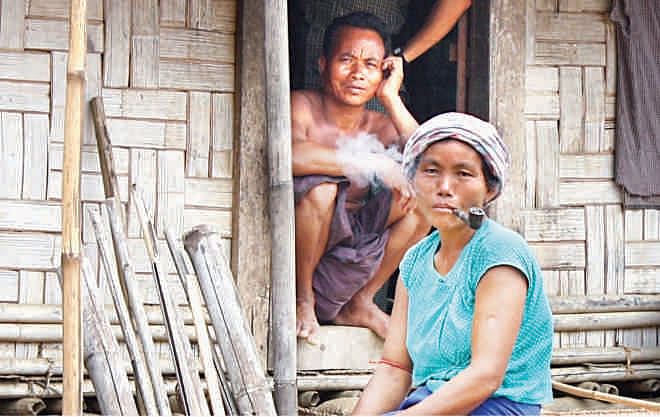A Tale of Two Peoples

A serene green landscape with foggy hills, brooks and rapids with crystal clear water can be deceptive of the true nature of the Chittagong Hill Tracts (CHT). It is actually one of the most turbulent regions of Bangladesh. The recent clashes between the Bengalis and the ethnic minorities of the CHT manifests the level of hatred we nurture in our own country even after four decades since our independence.
On the occasion of 67th anniversary of the partition of India, Bayaan Collective and the University Press Limited organised a series of seminars and discussions called Nations and Notions: Partition Week. It is there that we got an opportunity to look back at Chittagong Hill Tracts during 1947.

With the promulgation of land reform and direct taxation by the British government in 1935, the ruling class of different ethnicities lost their influence over the British rulers. Unlike the powerful princely states of India, the British Raj didn't pay any heed to the plights of these less powerful and 'non- aristocratic' ethnic leaders. When the partition of India on the basis of religion became evident, this 5000-square-mile of hilly land with mostly non Muslim population became a question of dispute. Tamina M Chowdhury, a PhD student of Cambridge University has been researching on the CHT and its annexation with Pakistan in 1947.
While presenting her paper in a seminar during the “Partition Week” Tamina says, “The Tracts remained outside the imagination of Bengal's political elites, and they made little or no attempt to reach out to its hill communities… They (the Congress) did not reach out to the tribes. Neither did the Muslim League nor did Fazlul Huq's Krishak Proja Party become involved, and make any effort to mobilise the hill people.”
Despite this reluctance of the political leadership, the leaders of different ethnic groups tried to reach the leaders of Congress to express their concern. Tamina's research revealed that a handwritten and unsigned letter was sent to J B Kripalani, the then President of Indian National Congress by the 'People of Chittagong' urging that Hill Tracts should be included in India.

But Congress was not willing. The CHT was considered so isolated from mainland Bengal that they took no noticeable step to acquire it. However another party representing the Hindus of India called the Hindu Mahasabha demanded the CHT to be a part of India. Despite the claims, the designer of the partition, Cyril Redcliffe had more things to consider. His main priority while chalking out the boundaries was to maintain the existing infrastructure. Since the Chittagong port was the only sea port of the then East Bengal and was to go with Pakistan, the Chittagong Hill Tracts also became a part of Pakistan to maintain the infrastructure of this significant sea port.
It was the beginning of calculated negligence towards the ethnic groups of this hilly region. Later in 1962, hundreds of villages went under the lake created by Kaptai hydroelectric power plant. Thousands of these people fled to India. Even after the independence of Bangladesh, incursion of Bengali settlers, and continuous insurgency have turned this heavenly landscape into a death zone.

But Chittagong Hill Tracts is not the only poster child of the fateful partition of 1947. Bangladesh will have to figure out a proper solution for over a million Urdu speaking people tagged as 'stranded Pakistanis'. Popularly known as Biharis these non-Bengali people lead a miserable life in some congested refugee camps in Dhaka. Some of them also reside in slums mainly beside large railways stations like Chittagong, Ishwardi and in railway towns like Sayedpur. During the partition week, Professor Dr Dina M Siddiqui and Professor Dr Pias Karim discussed the realities the Biharis are facing.

The non-Bengali refugees first started to come to this land after vicious riots broke out all over undivided India on the eve of partition. Professor Dina says, “Deadly riots in Bihar in the aftermath of Direct Action Day and the massacre of Hindus in Noakhali in 1946 were instrumental in the uprooting and relocation of Muslims from Bihar into Bengal.” Not only from Bihar but hundreds and thousands of Muslims from the districts bordering Bengal also started to come here.
But the influx of refugees continued long after the partition. During the Calcutta riot of 1950, anti-immigrant agitation in Assam, riots broke out in Madhya Pradesh and Uttar Pradesh and during the Pakistan-India war of 1965, millions of Muslims took shelter in the then East Pakistan. Many of them had just fled the riots, but some of them thought they arrived in the land of Islam. Due to their cultural difference with the Bengalis they were more inclined to the West Pakistani rulers which led them to favour the Pakistani occupation army in 1971.

Professor Dina interviewed several residents of the refugee camps for her research paper. One of the residents says, “Cigarettes between fingers and betel leaves in the mouth, we will fight and win Pakistan--who knew that this slogan would lead to this predicament?”
Now 43 years after the independence these people have been leading an inhuman life in the refugee camps with no minimum facilities. However, on November 26, the Stranded Pakistani Youth Rehabilitation Movement filed a writ petition seeking a high court order to recognise the Biharis as citizens of Bangladesh. On May 18, 2008, the court ruled in favour of the Biharis. The Biharis, for the first time in the history of Bangladesh, were able to cast their vote in the ninth national parliamentary elections in 2008.
But the process of rehabilitation has been stalled again. The recent attack on Bihari communities by land grabbers is a clear signal that we must solve the Bihari question by integrating them into our society.
During the partition of 1947, Chittagong Hill Tracts was an isolated part of the British Empire and so were the Biharis for the West Pakistanis. But in 2014 they are an indispensable part of our population. We must recognise that they enjoy equal rights protected by the constitution.


 For all latest news, follow The Daily Star's Google News channel.
For all latest news, follow The Daily Star's Google News channel. 



Comments